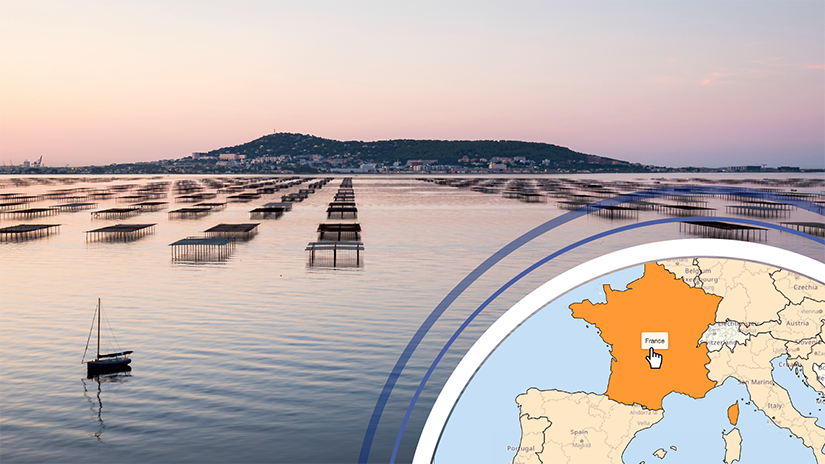Background information

Type of species farmed
Pacific oyster (Crassostrea gigas), blue mussel (Mytilus edulis), rainbow trout (Oncorhynchus mykiss), gilthead seabream (Sparus aurata).
Source: 2024, STECF
Type of production method
In 2022, 80 % of the French production occurred in sea and brackish waters and 20% in freshwater. The following main production methods were used:
Source: 2025, EUMOFA
The rest (5%) was farmed using other methods for which no detail is available.
Sector’s size (production and consumption)
Production (2022)
231.9 thousand Tn; 937 million € (2024, STECF)
Consumption of fishery and aquaculture products (2022)
32.58 Kg per capita
Variation in consumption (2022/2021)
1% (2024, EUMOFA)
Source: 2024, EUMOFA & STECF
Trends (past and future)
- Simplification of administrative procedures
- Spatial planning
- Animal health and welfare
- Environmental performance,
- Innovation
- Data collection and communication
Source: MNSPA
Impact of aquaculture in the country’s economy, food market and labour market
- Domestic production of aquatic products covers only a quarter of consumption.
- French shellfish farming is the second largest in Europe, with an average production of 140 000 tonnes of seafood. It is characterised by a high degree of heterogeneity in terms of farming conditions, both in terms of species (oysters, mussels, clams, etc.) and the diversity of production sites along the French coast.
- French fish farming is the third largest producer of freshwater trout in Europe. France also stands out as one of the world's leading caviar producers in the world (with 43 tonnes per year) and as a pioneer in the field of marine farming in Europe, thanks to its mastery of fish farming and fish feed.
- In recent years, the seaweed cultivation sector, in particular spirulina, is booming.
- These sectors are very dynamic in terms of research and innovation, especially in fish farming.
- However, in spite of the potential of these sectors, the development of aquaculture remains limited. The sectors face a lack of attractiveness, linked to difficult working conditions, the lack of image among the population and the low social acceptability of new projects.
- French aquaculture contribute to the development of the coastline and rural territories, as they provide create jobs that cannot be relocated, within family businesses.
- Increasing aquaculture production to supply local consumption and an improvement in aquaculture quality.
Source: MNSPA
Challenges and opportunities
- French aquaculture must meet the expectations of society and citizens and maintain a high level of economic and environmental performance.
- The challenges of today and tomorrow lie more in the continued legal reinforcement of installations and the implementation of the progress plan to facilitate the development of fish farms, including freshwater pond fish farming.
- The sector should continue to position itself in foreign markets, while supplying the domestic market with healthy products with a low carbon footprint and high added value.
- Focusing on the caviar quality: Consolidate current market shares, with the future PGI. "Caviar d'Aquitaine".
- Developing smoked trout production to supply a growing and demanding national market.
- Pond fish farming: to reverse the trend by supporting these extensive farms, which contribute to biodiversity, local animation and the supply of local proteins.
- Strengthening shellfish farming: new developments prospects, new locations, new products, new markets.
- Improving aquaculture image in terms of environmental impact, to which is added the issue of animal welfare.
- Enabling the development of Integrated Multi-Trophic Aquaculture (IMTA).
- Produce healthy and well-treated fish that meet health and societal requirements, with a viable economic model and by-products generated in complete safety.
- French aquaculture has strong growth potential.
- Aquaculture products contribute to the diversification protein sources and offer a local supply with a limited carbon footprint.
- Potential development of mussel and oyster productions.
- Approaching a new target production (1000 Tn by 2027) in the seaweed aquaculture production with a great potential market. It’s a young sector: it combines the cultivation of macroalgae, microalgae and cyanobacteria (spirulina).
- Promoting individual and collective actions of vigilance to keep preservation of marine space and improving the quality of shellfish waters and maintaining the maritime public domain in order to preserve and even restore these areas dedicated marine farming.
- The development of new offshore production methods, e.g., taking advantage of offshore wind energy zones, will have to be taken into account. Maritime safety issues will have to be taken into account in the implementation of these projects.
Source: MNSPA
Employment and number of enterprises
2 817 companies employing 19 345 persons (11 332 full time equivalent)
Source: National Aquaculture Survey Data
Multi-annual National Strategic Plans for the development of sustainable Aquaculture
Relevant Authorities
- Ministry of Agriculture and Food Sovereignty
- State Secretariat for the Sea
- General Directory for Maritime Affairs, Fishery and Aquaculture (DGAMPA) under the joint supervision of the Ministry of Agriculture and the State Secretariat for the Sea.
Applicable Legislation
- Code de la santé publique (Partie législative). Date of text: 15 June 2000
- Code rural et de la pêche maritime (Partie législative). Date of original text: 2018 (02 September 1979, 2018)
Loi n° 2010-874 de modernisation de l'agriculture et de la pêche. Date of original text: 27 July 2010 (01 March 2017)
- Code de la santé publique (Partie réglementaire). Date of text: 2000
- Code rural et de la pêche maritime (Partie réglementaire). Date of original text: 1979 (02 September 2018)
Applicable Procedures
- From 20 tonnes produced per year, a fish farm falls under the ICPE authorisation regime, and the environmental assessment on a case-by-case basis, involving indispensable environmental procedures.
- Animal health approval
Relevant Websites
Contact Details
Uploads
Summary in English of the "Published National Strategic Plan on Aquaculture" for France
